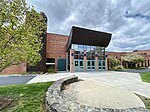The International Museum of World War II was a nonprofit museum devoted to World War II located in Natick, Massachusetts, a few miles west of Boston. It was formed over a period of more than 50 years by its founder, Kenneth W. Rendell, one of the world's premier dealers in autographs, letters and manuscripts, who has earned international renown as an authenticator of historic artifacts. The museum's collections documented the events of the war, from the signing of the Treaty of Versailles ending World War I to the Nuremberg and Tokyo war crimes trials. The museum's goal was to preserve the reality of the history of World War II and to provide an educational experience of the lessons to be learned. In 2016, the Museum of World War II became The International Museum of World War II to reflect its being the only museum in the world with an international collection of letters, documents, and artifacts.
On September 1, 2019, the museum closed without prior notice. Much of the museum's collection had been sold to billionaire Ronald Lauder; the agreement to keep the museum open while a new home was found was terminated by Lauder.On display were over 7,000 artifacts as well 103 mannequins outfitted in complete uniforms and military equipment. Every piece is authentic, from documents with the handwriting of Franklin D. Roosevelt to the actual uniforms worn by concentration camp prisoners. The collections include highly important wartime letters, documents and manuscripts of all the major political and military leaders, as well as the papers of officers and soldiers of all ranks, concentration camp inmates and civilians. Adolf Hitler, Roosevelt, Winston Churchill, Dwight D. Eisenhower, George S. Patton, Bernard Montgomery, Joseph Stalin, Erwin Rommel, Benito Mussolini, Joseph Mengele, Adolf Eichmann, Raoul Wallenberg and Anne Frank's family are all represented in original letters.
The museum has been praised for the scope of exhibits in its collection. Rendell has said that "if a visitor is overwhelmed with the enormity and the complexity of the war, I have achieved my goal."












